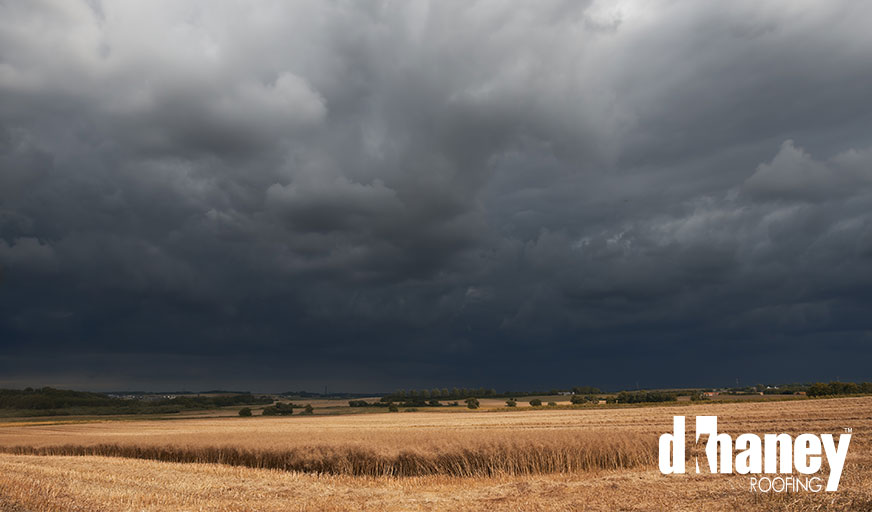Most business people have heard or used the phrase, “a perfect storm” to suggest a situation where all factors seemed to have lined up to create a fiasco. Protect Your Commercial Roof during the spring and early summer months, when tornadoes, hail storms, and thunderstorms can wreak havoc on properties and commercial buildings, a perfect storm can turn a roof into a perfect mess! That’s why savvy building managers rely on professional roofing contractors to anticipate the potential destruction and quickly repair storm damage.
The Storms of Life
According to Royce Martin, the director of Operations for DK Haney Roofing, spring and summer storms are often severe and accompanied by high winds. “Wind can catch the edge of the roof,” he said, “And it can blow the entire roof off. This is why there are different – more stringent building codes – in places where tornadoes or hurricanes are likely. Some local building codes in these areas mandate that these roofs must be able to withstand 150 miles per hour winds!
“Hail can also take years off the life of a commercial roof while destroying AC units and skylights and leading to water leaks into the interior of the building. Many building owners have realized the benefit of single-ply membranes for reducing the damage from hail. Hail might “ding” the roof membrane, but it is unlikely that it will penetrate it.
“The metal material, called ‘flashings,’ which help protect the integrity of the roof, is welded to the membrane, so they are not as likely to become untethered. However, hail can certainly crack the joints and cause damage to the building.
“Finally, standing water on the roof is another problem, especially during storm seasons. Regular roof maintenance and inspections include checking the drainage and clearing brush and debris. You would be surprised to see the trash that accumulates on a roof. Plastic bottles, food wrappers, and other trash left by other workers can clog the drains and result in standing water. If there is even a small puncture from say a screw that has been left behind and stepped on, water can find that vulnerable spot and ultimately leak into the interior of the building.”
Storm Chasers: Caveat Emptor
The “Weather Channel” is famous for its reports from “storm chasers.” These intrepid souls follow weather events with their cameras and bring those images back to the viewers who are “high and dry.” Unfortunately, there is another group of “storm chasers” who show up in a city after a storm has occurred. These can be migrating, fly-by-night roofers and are one of the most dangerous parts of dealing with storm damage and they should be avoided at all costs! Know who you are dealing with.
“Always check the credentials (license, insurance coverage, references) of anyone purporting to be a professional roofer, especially if they ‘just happen to be in the neighborhood after a storm,” Martin said. “Post-storm is ‘prime time’ for scam artists and a good time for property managers to remember: caveat emptor (buyer beware).”
Two Approaches to Storm Planning
“There are 2 types of maintenance agreements that building owners and property managers can take advantage of to protect their property,” Martin said. “These are a proactive agreement and a reactive agreement. With our proactive agreement, we work with the building owner throughout the year and manage the life of the roof with regular inspections. With our reactive agreement, if a weather event occurs and the owner calls us out after the storm we come right out.
“Once our inspection team is on the roof, we do a thorough inspection to ensure that wind or hail has not opened the building up to future or current water damage.
“An important part of our proactive plan is our online client maintenance portal. It enables the property manager or owner to have real-time reports on maintenance and inspections that have occurred on the roof. This information is critical when damage occurs and when covered by a manufacturer’s warranty.
“With new clients on a proactive agreement, we do an initial inspection and add the results into the client portal. The client can then login and view the information including the condition assessment and make decisions based on cost estimates and other factors to repair and extend the life of the roof. We also upload any warranties, and if any manufacturer defects are found, we will assist them in the claim process as well.
“Finally, most commercial property managers are not roofers and can’t be expected to be experts. But they do know that the roof is one of the most expensive assets that they are charged to protect. They know the value of vetting their roofers and finding a true partner that will work to preserve their assets on a long-term basis.”
Is your commercial roof due for an inspection? Are you seeing tell-tale signs of water leaks? Contact us for a no-obligation consultation.

